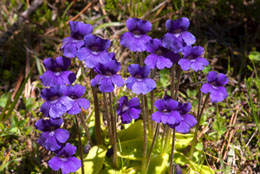If insects are a constant menace to your garden or in your home, then you can consider buying yourself a lifesaving butterwort plant. Let's see why they're such great plants for homes.

When we think of plants, we imagine beautiful petals, lush green foliage, delicious fruit, and yes, bees and butterflies hovering around them. These are plants which fancy savory insects. They hail from the genus
Pinguicula. The reason behind this carnivorous urge, is the insufficiency of mineral nutrition from the environment. These plants have adapted to the surroundings using a luring method to attract prey.
The butterwort plant produces some really bright flowers, which are too attractive to be ignored. These very flowers lure insects to come in proximity with it. The leaves of the plant house several tiny glands that work to produce a slimy substance. This substance is actually visible as tiny droplets across a leaf's surface, giving the leaves a slick look. The insects may also get attracted to the plant in search of water, apart from the flowers.
Once the insects come into contact with these leaves, an additional amount of this slimy liquid is released by the plant, thus, trapping the creature. Thereafter, enzymes are released and they begin to dissolve or break down the digestible components of the insect's body. And the fluid that results is absorbed by the leaves.
Interesting Butterwort Facts
- Butterworts are found in areas which lack a nutrient-providing environment. This is why they've evolved into carnivores.
- Butterworts are of two types; tropical and temperate.
- Apart from small insects and those with large wing surfaces, these plants are also known to feed on pollen. Common treats on their menu include spiders, slugs, flies, caterpillars, crickets, and the like.
- One historical fact about this plant, is that earlier, northern Europeans used its leaves to treat cattle sores. This use emerged from the fact that these plants were known to produce a strong bactericide. This very substance keeps the preyed insects from rotting.
- Most of these species reproduce asexually by vegetative reproduction. Although, sexual reproduction is also possible.
- The mountainous regions of Central America happen to be the home of the largest population of these insect-devouring plants.
- During the growing stage, butterworts require constant moisture or wet habitats to achieve optimum development.
- To survive a winter drought, most species of this plant which are of a Mexican descent, shed their carnivorous leaves and develop a protective case-like feature, called a hibernacula.
- To grow this plant, well-drained soil that is low in nutrients is required.
- Partial sun or even shady conditions is suitable for these plants.
- Watering is required on a daily basis. However, the soil must not be too wet nor too dry. During winter, watering can be done between dry spells.
- Rainwater or distilled water is recommended for use.
Certain butterwort species are widely cultivated in commercial orchid nurseries as natural pest controllers, protecting other plants in the vicinity, from harm.






 When we think of plants, we imagine beautiful petals, lush green foliage, delicious fruit, and yes, bees and butterflies hovering around them. These are plants which fancy savory insects. They hail from the genus Pinguicula. The reason behind this carnivorous urge, is the insufficiency of mineral nutrition from the environment. These plants have adapted to the surroundings using a luring method to attract prey.
When we think of plants, we imagine beautiful petals, lush green foliage, delicious fruit, and yes, bees and butterflies hovering around them. These are plants which fancy savory insects. They hail from the genus Pinguicula. The reason behind this carnivorous urge, is the insufficiency of mineral nutrition from the environment. These plants have adapted to the surroundings using a luring method to attract prey.